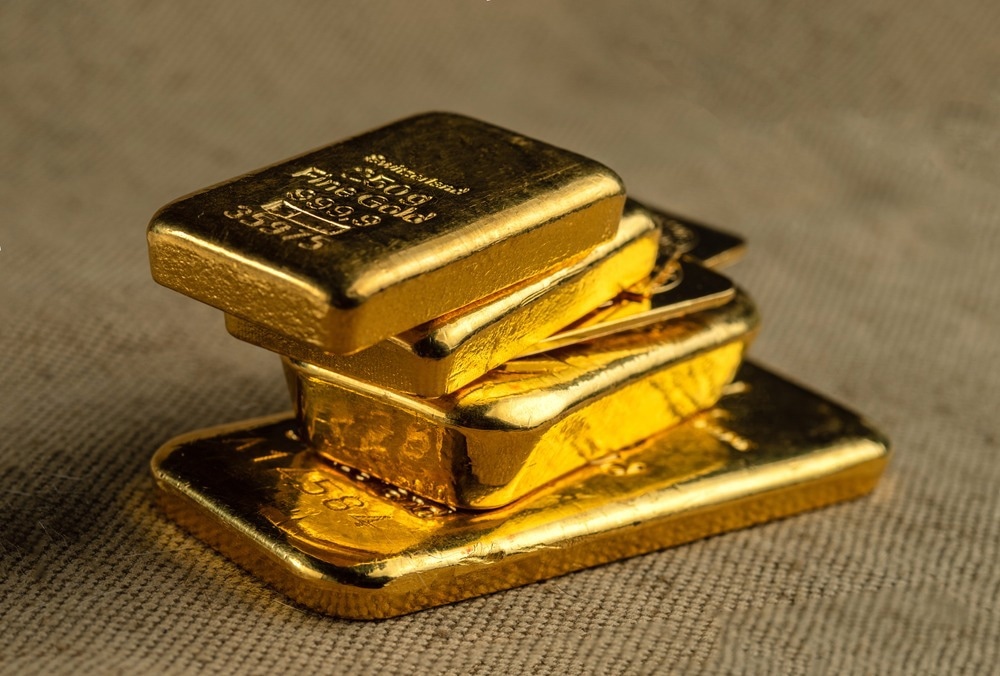Updated by Reginald Davey 10/01/23
Gold is a soft metal with a characteristic yellow color. It is also the most malleable and ductile of all elements. Except for aqua regia", HNO3/HCl, gold is not affected by water, air, acids, and alkalis. The fact that this metal is chemically unreactive means that it is usually found in its natural state.

Image Credit: VladKK/Shutterstock.com
The symbol for gold is Au, and it has an atomic number of 79. It is commonly found in nature as nuggets and granules and is extracted from alluvial deposits and veins.
Gold is a superior electrical and thermal conductor and has excellent reflective properties to both infrared and visible light. It is found in the earth's crust with an abundance of 0.0011 ppm.
Uses of Gold
Gold has been treasured for millennia due to its beauty. This precious metal has extreme permanence, with ancient treasures recovered from archaeological digs still retaining their luster even now, centuries or millennia since they were initially produced.
Until recently, gold was primarily used as a monetary metal. Most of the gold throughout history has been retained for use as bullion reserves, but it is also used within the jewelry industry to produce decorative products.
In recent decades, gold has found widespread application as an essential industrial metal. This is due to its lack of corrosion and superior electrical conductivity, as well as several other beneficial physical and chemical properties. Gold occupies a unique place amongst commodities as it is a long-term value store due to its lack of reactivity with the environment and corrosion.
It is a crucial material in the electronics and computer industries, used in computers, jet engines, spacecraft, communications equipment, and many other key products. Gold is also used as a decorative medium as well as a heat-reflecting coating for glass.
Gold is also used in the biomedical industry. Common uses include colloidal gold in antigen tests and coatings for biological specimens and dishes used in scanning electron microscopes. Injectable gold can be used to treat conditions such as tuberculosis and rheumatoid arthritis.Gold-198, an isotope, is increasingly being used in cancer treatments.
Gold is used in aircraft cockpit windows for de-icing, in astronaut helmets, and as a protective coating in building glass to reflect solar radiation. Another application is in photography, which produces red tones when photographs are developed.
Global Gold Producers and Reserves
Until 2006, South Africa was the primary gold producer. China, Australia, Russia, the United States, and Canada are the top five gold-producing countries in the world today. As of 2021, global gold reserves are 54,000 metric tons. Global gold reserves remained relatively stable between 2010 and 2021. The US has the largest gold reserves of any country.
Gold Purity and Gold Fineness
Gold purity is expressed in carats, often abbreviated to ‘ct’ of ‘K’ in the USA and some other countries. Pure gold has a purity of 24 carats. Various other purities exist that are measured relative to 24 carats. These are summarized in the table below.
Table 1. The relationship between gold content (by weight), its carat rating and hallmark rating for standard gold alloys.
| Purity |
Gold content (wt. %) |
Fineness |
| 24 carat gold |
99+ |
990 |
| 22 carat gold |
91.6 |
916 |
| 18 carat gold |
75.0 |
750 |
| 14 carat gold |
58.5 |
585 |
| 9 carat gold |
37.5 |
375 |
An alternative method of expressing purity is ‘gold fineness’. This expresses the purity of gold in parts per 1000.
Gold may be alloyed with other metals such as silver, copper, zinc, or silicon to produce purities less than 24 carats. Silver and copper are the most commonly used alloying elements for gold. This improves its use in the jewelry industry, as pure gold is too soft for producing jewelry.
The metal chosen as an alloying element can influence properties such as the workability and color of the resultant gold alloy.
The purity of the gold is ‘marked’ onto jewelry by stamping or laser engraving. This acts as a quality control stamp. Often this is done after the alloy is tested by a qualified testing laboratory or facility. Depending on which country the gold is produced in, the carats or fineness may be stamped into the item of jewelry.
According to the International Hallmarking Convention, there is a “no negative tolerance” policy. This means that a gold alloy determined to consist of 749 parts of gold per 1000 would not qualify for a 750 quality mark.
Methods used to assay or test the purity of gold include:
- Inductively Couple Plasma Spectrometry (ICP)
- X-Ray Fluorescence
- Fire Assay
- Touchstone
- Electronic Pen
- Density
More from AZoM: Gold - Applications in Electronics, Biomaterials and Catalysis
Source: AZoM.com